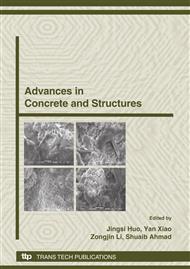p.121
p.125
p.131
p.137
p.145
p.151
p.157
p.163
p.169
Water Repellent Treatment on Lime/Lime-Fly Ash/Lime-Cement Mortar with and without Carbonation
Abstract:
Water repellent treatment (WRT) has proved to be effective to prevent porous materials from water penetration and consequently can improve the durability of structures. In this contribution, three types of mortar, which are pre-carbonated and non-carbonated, had been water repellent treated by silane gel with usage of 400 g/m2, to investigate into the influence of WRT on carbonated and non-carbonated mortar. Results indicate that carbonation reaction increased the compressive strength of all three types of mortar. Silane gel penetrated to a comparatively higher depth for the carbonated mortar. WRT reduced the absorbed water and capillary absorption coefficient greatly, both for non-carbonated mortar to 2 % ~ 7 % and for carbonated mortar to 22 % ~ 66 %, compared with non-treated ones. WRT is still a feasible method for porous materials with some carbonation to prevent from water penetration. However, the efficiency of WRT on reducing capillary absorption became much lower compared with the non-carbonated mortar. Capillary absorption curves of non-WRT mortar, both carbonated and non-carbonated, could be well fitted by a hyperbolic function of square root of time. For the treated mortar, the absorption curves could be described as a linear equation before carbonation, but an exponential function when the mortar carbonated.
Info:
Periodical:
Pages:
145-150
Citation:
Online since:
October 2008
Authors:
Price:
Сopyright:
© 2009 Trans Tech Publications Ltd. All Rights Reserved
Share:
Citation:


